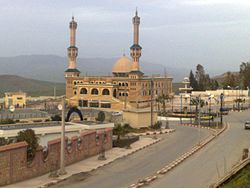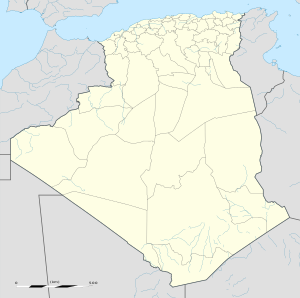Mila, Algeria
|
Mila ميلة |
|
|---|---|
| city | |

Mila town
|
|
 city Mila in Mila Privince |
|
| city Mila in Mila Privince | |
| Coordinates: 36°27′00″N 6°16′00″E / 36.45°N 6.266667°E | |
| Country |
|
| Province | Mila Province |
| District | Mila District |
| Area | |
| • Total | 50.15 sq mi (129.89 km2) |
| Population (2008) | |
| • Total | 69,052 |
| Time zone | CET (UTC+1) |
Mila (Arabic: ميلة) is a city in the Northeast of Algeria, capital of Mila Province. In antiquity, it was known as Milevum (in Latin) or Miraeon, Μιραίον (in Ancient Greek) and was situated in the Roman province of Numidia.
In Ptolemy's "Geography", IV, iii, 7, the city is mentioned under the name of Mileum or Mireon. During the Roman era it was called Colonia Sarnensis Milevitana, after the River Sarnus in Campania, whence the colonists had emigrated. This name is often found in the inscriptions of the city. Together with Cirta, Collo and Rusicade, Milevum formed the confederation known as the Four Colonies, the territory of which was very extensive. In the 6th century the Byzantine Emperor Justinian had Milevum enclosed by a fortified wall, which still stands and forms a rampart for the Muslim city of Mila. It has yielded quite a number of Latin inscriptions from this city and a colossal statue of Saturn.
Two church councils were held at Milevum, one in 402 and the other in 416. The second appealed to Pope Innocent I for repression of the Pelagian heresy. Among the bishops of this episcopal see were Pollianus, present at the Council of Carthage in 255 and martyred two years later; St. Optatus, noted for his work against the Donatists, who died in about 385, and who is commemorated on 4 June; Honorius; Severus, fellow-countryman and friend of St. Augustine Benenanus (484); Restitutus, who attended the Fifth Œcumenical Council in 553.
...
Wikipedia

